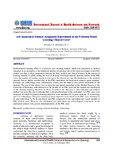Are anatomical sciences adequately represented in the problems-based learning clinical cases?

View/
Date
2015-02Author
Missankov, A.
Missankova, K. I.
Publisher
ScopeMed Journal Management System, http://www.scopemed.orgRights holder
Copyright 2011. International Journal of Health Sciences and ResearchType
Published ArticleMetadata
Show full item recordAbstract
Problem-based learning (PBL) is a relatively new teaching method, which was introduced in medical education as an alternative to the traditional method of teaching. One of the major advantages of the PBL method was that, it allows integration between the basic medical and clinical sciences. In the process of learning anatomy, in a PBL setting, the level of anatomy knowledge depends upon the number of the PBL cases, the number of learning objectives relevant to the clinical case and the distribution of the teaching material. Earlier studies reported that, in the PBL curriculum, the anatomical sciences (gross anatomy, histology and embryology) were insufficiently covered and the subjects were poorly understood by the students. The aim of this project was to study the preclinical curriculum at the Medical Faculty of the University of Botswana, with references to the number of the PBL cases and the amount and distribution of the anatomy learning objectives in them. To achieve the objective, a data collection and analysis method was used. The results indicated that, in the preclinical part of the curriculum, 123 PBL cases were discussed, in which 94 anatomy learning objectives were identified (63 in gross anatomy, 26 in histology and 5 in embryology). The gross anatomy learning objectives were absent in 44 PBL cases, histology in 51 and embryology in 98. In conclusion, the PBL component of the curriculum had a good number of PBL clinical cases. However, the histological and particularly the embryological components of the anatomical sciences were grossly underrepresented, in the PBL cases.
